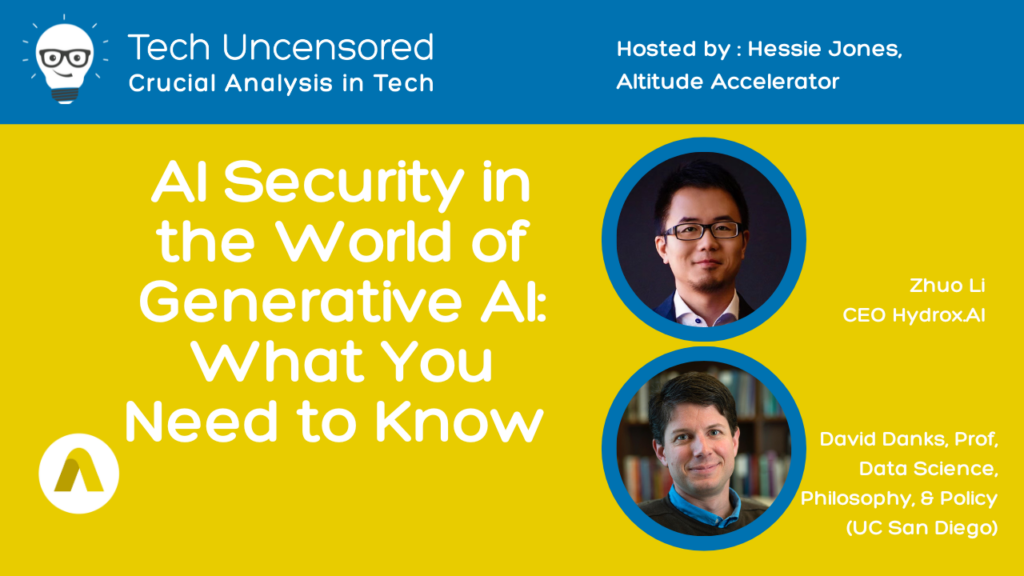Home » Understanding AI Security in the Era of Generative AI: Essential Insights
Understanding AI Security in the Era of Generative AI: Essential Insights

In a recent discussion between Hessie Jones, David Danks, and Zhuo Li, they explored the rapid evolution of generative AI technologies, highlighting significant shifts in how we understand artificial intelligence. This “paradigm shift,” mainly accelerated by models like ChatGPT, has introduced a multi-purpose functionality, allowing AI to perform a variety of tasks rather than being optimized for singular tasks as seen in traditional AI. David Danks explained how these systems leverage natural language interfaces, enhancing user interaction and enabling customized outputs based on user inquiries.
Nonetheless, the conversation also delved into the risks associated with these widespread AI applications. While generative AI provides remarkable capabilities, it still exhibits errors akin to its predecessors, such as “hallucinations” where AI generates false statements or misrepresents information. New risks have emerged, particularly due to the accessibility of these systems. With a user-friendly prompt-based interface, individuals with malicious intent can exploit AI technologies more readily, increasing the chances for misinformation and accidental misuse.
Confidentiality concerns were highlighted, particularly regarding how data is handled within these models. Both Danks and Li warned of the dangers posed by inadvertently inputting proprietary or sensitive information into generative AI platforms. Organizations are increasingly seeking customized in-house models to ensure data protection and operational security, a trend evident in institutions like UC San Diego, which has developed its version of AI to handle sensitive academic data.
Zhuo Li, drawing from his background in privacy at TikTok and current focus as CEO of Hydrax AI, emphasized the importance of understanding AI systems. He pointed out the differentiation of security measures between traditional technology and today’s complex AI models. Traditional practices, based on established structures, are insufficient amidst the unpredictability of generative AI outputs. As AI technologies become more integrated into critical sectors like healthcare and finance, the need for robust safety standards and security protocols is urgent, given the implications of potential data breaches or erroneous outputs.
The discussion also addressed the concept of synthetic data in relation to the abundance of available data. Both speakers agreed that while we may be reaching limits in accessing public domain data readily available on the internet, substantial data remains locked behind private domains. Synthetic data could play a role in bridging these gaps, particularly when combined with real datasets to enhance model training. However, David Danks caution that synthetic data's utility is highly contingent on the validity of the models that generate it.
Finally, the speakers touched on the burgeoning landscape of AI regulation. With various governance efforts emerging globally, there's a distinct challenge in harmonizing and standardizing approaches across different jurisdictions. Danks noted that while current governance mechanisms are developing, achieving consistency in regulation globally is a major hurdle given the differing methodologies in places like the U.S., EU, and China.
In conclusion, there's a sense of hope amid the uncertainty surrounding AI's trajectory, driven by potential improvements in safety and data handling. However, as the technology evolves, the way organizations and regulators respond will significantly shape the future of generative AI. This evolution presents both opportunities and challenges for innovation, governance, and ethical AI usage.
Altitude Accelerator
https://altitudeaccelerator.ca/
Altitude Accelerator is a not-for-profit innovation hub and business incubator for Brampton, Mississauga, Caledon, and other communities in Southern Ontario. Altitude Accelerators’ focus is to be a dynamic catalyst for tech companies. We help our companies grow faster and stronger. Our strength is our proven ability to foster growth for companies in Advanced Manufacturing, Internet of Things, Hardware & Software, Cleantech and Life Sciences. Our team consists of more than 100 expert advisors, industry, academic, government partners. The team helps companies in Advanced Manufacturing, Internet of Things, Hardware & Software, Cleantech and Life Sciences to commercialize their products and get them to market faster.


